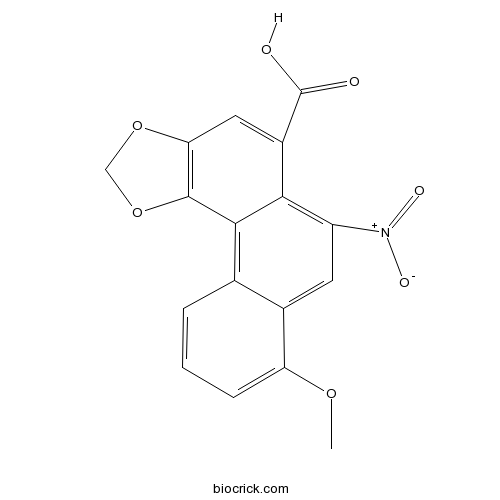Aristolochia mollissima
Aristolochia mollissima
1. The products in our compound library are selected from thousands of unique natural products; 2. It has the characteristics of diverse structure, diverse sources and wide coverage of activities; 3. Provide information on the activity of products from major journals, patents and research reports around the world, providing theoretical direction and research basis for further research and screening; 4. Free combination according to the type, source, target and disease of natural product; 5. The compound powder is placed in a covered tube and then discharged into a 10 x 10 cryostat; 6. Transport in ice pack or dry ice pack. Please store it at -20 °C as soon as possible after receiving the product, and use it as soon as possible after opening.
Natural products/compounds from Aristolochia mollissima
- Cat.No. Product Name CAS Number COA
-
BCN2902
Aristolochic acid D17413-38-6
Instructions

-
BCN6262
Aristolochic acid A313-67-7
Instructions

A study on the anticancer activity of ethanol extract of Aristolochia mollissima Hance on osteosarcoma HOS cells.[Pubmed: 24311886]
This paper mainly studied the extraction process of traditional Chinese medicine Aristolochia mollissima Hance (Aristolochiaceae) and the inhibitory effect of its extracts on osteosarcoma HOS cells. The extraction process included the ultrasonic extraction method, heat reflux method and decoction method to obtain three different extracts. MTT assay was used to test the effect of the extracts on proliferation of HOS cells, to compare the degree of inhibitory activity of three extracts, and to calculate cell survival rates. The results showed that among the three extracts obtained by the ultrasonic extraction method, heat reflux method and decoction method, the one obtained by ultrasonic extraction has the largest yield, but the extract obtained by heat reflux method has the strongest anticancer activity. Nevertheless, the three extracts all have a good inhibitory activity on the proliferation of osteosarcoma HOS cells.
Identification of Baiying (Herba Solani Lyrati) commodity and its toxic substitute Xungufeng (Herba Aristolochiae Mollissimae) using DNA barcoding and chemical profiling techniques.[Pubmed: 22953906]
Baiying derived from Solanum lyratum Hance is a commonly consumed natural product for ethnomedical treatment of cancer. One of the substitutes present in the market is a carcinogenic aristolochic acids-containing herb Xungufeng derived from Aristolochia mollissima Thunb. The purpose of this study is to establish DNA barcodes, thin layer chromatography (TLC), high performance liquid chromatography (HPLC) and cytotoxicity assay to differentiate Baiying from Xungufeng. A total of 30 DNA sequences from five DNA barcodes (ITS, matK, rbcL, trnH-psbA and trnL-trnF) were generated to differentiate S. lyratum from A. mollissima and authenticate ten samples of Baiying and Xungufeng commodities. Using aristolochic acids as standard markers, TLC and HPLC analyses also successfully authenticated these commodities. In vitro cytotoxicity assay using HEK-293 and Vero cells demonstrated that Xungufeng was significantly more toxic than Baiying. This is the first study applying an integrated molecular, chemical and biological approach to differentiate traditional Chinese medicine from Aristolochia adulterant.
Composition, antimicrobial activity and cytotoxicity of essential oils from Aristolochia mollissima.[Pubmed: 21783753]
The compositions of the essential oils from the rhizome and the aerial part of Aristolochia mollissima were analysed by GC-MS, 68 constituents (88.2% of the total oil) and 74 constituents (89.4% of the total oil) were identified, respectively. 2,2,7,7-Tetramethyltricyclo[6.2.1.0(1,6)]undec-4-en-3-one was the most abundant constituent among all in the ratios of 15.9% and 13.5% from the rhizome and the aerial part of A. mollissima, respectively. Among other main compounds, (E)-β-santalol acetate (10.3%) and camphene (6.7%) were detected in the rhizome oil, spathulenol (6.8%) was detected in the oil from the aerial par of A. mollissima. The antimicrobial activity of the essential oils from the rhizome and the aerial part of A. mollissima was evaluated against 20 microorganisms using disc diffusion and broth microdilution methods. The gram-positive bacteria were more sensitive to both oils than gram-negative bacteria and yeasts. The rhizome oil showed the strongest bactericidal activity against Staphylococcus saprophyticus, whereas the oil from the aerial part of A. mollissima exerted the strongest bactericidal activity against methicillin-resistant and methicillin-senstive Staphylococcus aureus. The in vitro cytotoxicity of both oils on six human cancer cell lines were also examined. The cytotoxicity of the rhizome oil on four cancer cell lines (ACHN, Bel-7402, Hep G2 and HeLa) was significantly stronger than that of the oil from the aerial part of A. mollissima.
Constituents of the roots and stems of Aristolochia mollissima.[Pubmed: 11170669]
Five new sesquiterpenes, mandolins R (1), S (2), U (3), W (4), and X (5), together with 39 known compounds, were isolated from the dried roots and stems of Aristolochia mollissima. Their structures were determined by spectroscopic methods.
[Chemical studies on Aristolochia mollissima V].[Pubmed: 2816393]
Two new phenanthrene compounds, 9-ethoxyaristololactam and 9-ethoxy-aristolactone, were isolated from the root of Aristolochia mollissima. Their structures were identified by means of spectral analysis.


